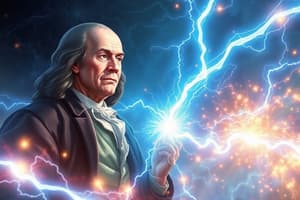Podcast
Questions and Answers
What is the conventional direction of current flow in an electrical circuit?
What is the conventional direction of current flow in an electrical circuit?
- Only from the negative terminal
- From negative to positive
- In random directions
- From positive to negative (correct)
Electrons flow from the positive terminal to the negative terminal in a circuit.
Electrons flow from the positive terminal to the negative terminal in a circuit.
False (B)
What is the unit of measure for electric current?
What is the unit of measure for electric current?
Ampere
Voltage is the measure of energy per unit charge available to drive electrons through a circuit. It is often referred to as the __________ pushing electrons.
Voltage is the measure of energy per unit charge available to drive electrons through a circuit. It is often referred to as the __________ pushing electrons.
Which type of current flows in one direction only?
Which type of current flows in one direction only?
Match the following terms with their definitions:
Match the following terms with their definitions:
Which of the following materials typically shows constant resistance?
Which of the following materials typically shows constant resistance?
What are the two types of materials based on their resistance characteristics?
What are the two types of materials based on their resistance characteristics?
What is the primary relationship described by Ohm's Law?
What is the primary relationship described by Ohm's Law?
Joule's Law states that power is directly proportional to the resistance of a conductor.
Joule's Law states that power is directly proportional to the resistance of a conductor.
What unit is used to measure resistance?
What unit is used to measure resistance?
According to Ohm's Law, if the voltage is doubled while the resistance remains constant, the current will also be ______.
According to Ohm's Law, if the voltage is doubled while the resistance remains constant, the current will also be ______.
Match the circuit components with their symbols:
Match the circuit components with their symbols:
Which of the following statements is accurate regarding non-linear components?
Which of the following statements is accurate regarding non-linear components?
Labeling a circuit diagram is unnecessary for understanding the components.
Labeling a circuit diagram is unnecessary for understanding the components.
What happens to the power dissipated in a resistor if the current flowing through it is tripled?
What happens to the power dissipated in a resistor if the current flowing through it is tripled?
Flashcards are hidden until you start studying
Study Notes
Electrons as Current
- Electric current (I) is the flow of electric charge, primarily carried by electrons in conductors.
- Electrons move from the negative terminal to the positive terminal of a power source.
- Conventional current flow is defined from positive to negative, despite the actual electron flow being the opposite.
Voltage, Current, and Resistance
- Voltage (V) measures the energy per unit charge driving electrons through a circuit, akin to pressure in a pipe.
- Potential difference is the voltage difference between two points that propels electrons.
- Current (I) indicates the rate of charge flow through a circuit; it flows continuously in direct current (DC) and reverses in alternating current (AC).
- Drift velocity refers to the slow movement speed of electrons in a conductor, while electrical signals travel at nearly the speed of light.
- Resistance (R) quantifies the opposition a material presents to electric current and varies with material properties, length, cross-sectional area, and temperature.
- Ohmic materials maintain constant resistance, while non-ohmic materials exhibit variable resistance in response to voltage.
How a Resistor Works
- Resistors create specific resistance to current flow, controlling current, dividing voltages, and protecting components in circuits.
- Joule’s Law describes the heating effect in resistors, where electrical energy converts to heat due to electron collisions: ( P = I^2 R ).
Units of Measurement
- Voltage is measured in volts (V), defined as the potential difference that drives 1 ampere through a 1 ohm resistance.
- Current is measured in amperes (A), equivalent to the flow of one coulomb of charge per second.
- Resistance is measured in ohms (Ω), allowing 1 ampere of current under a voltage of 1 volt.
Effect of Voltage on Current
- Ohm’s Law ( ( V = I \times R ) ) states that current is directly proportional to voltage and inversely proportional to resistance in resistive components.
- Non-linear components like diodes and transistors exhibit complex voltage-current relationships, often described by nonlinear equations.
Circuit Symbols
- Battery: Represented by a pair of lines; longer line for positive terminal, shorter for negative.
- Lamp/Globe: Illustrated as a circle with a filament symbol inside for light emission.
- Resistor: Depicted by a zigzag line indicating resistance to current flow.
- Switch: Open switch has a break indicating no current flows; closed switch connects two points allowing current flow.
Ohm’s Law
- The formula ( V = I \times R ) allows calculation of voltage, current, or resistance when the other two variables are known.
- It is foundational for circuit design and analysis.
Doubling Voltage Doubles Current
- In Ohmic materials, doubling voltage will double current if resistance remains constant, as defined by the relationship ( I = \frac{V}{R} ).
Labeling a Circuit
- Circuit diagrams should have each component labeled with names and values including power sources, resistors, capacitors, and switches.
- Proper labeling aids in understanding functions, troubleshooting, and ensuring accurate circuit construction and analysis.
Studying That Suits You
Use AI to generate personalized quizzes and flashcards to suit your learning preferences.




